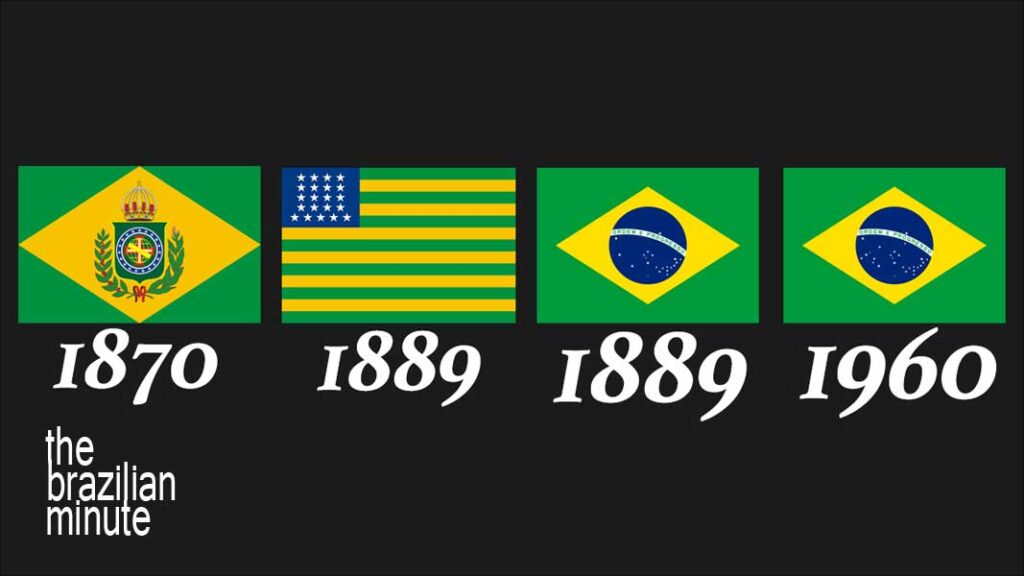
When It Comes To flags of the world, Brazil’s is pretty special
Brazil’s national flag is not only a symbol of one of the largest democracies in the world. Its design reflects the nation’s history and its vision.
This series was presented by the Consulate-General of Brazil in Chicago and the Brazilian Foreign Ministry’s Cultural Department.
In celebration of Brazil’s Bicentennial year, 1822 – 2022
This week’s Brazilian Minute: Brazil’s National Flag
(Audio not available)
Catch up with other Brazilian Minute episodes you may have missed!
Script from Audio:
Brazil’s national flag is one of the world’s most impressive.
Its green banner carries a yellow diamond at its center which holds a deep blue disc with stars depicting the southern sky as seen over the city of Rio de Janeiro on the morning of Brazil’s Proclamation of the Republic, November 15, 1889.
The 27 stars represent each Brazilian state plus the Federal District of Brasilia. Brazil’s national motto “Ordem e Progresso” rests on an arching, white banner.
Green represents the house of Bragança, the family of Brazil’s first Emperor, Dom Pedro. Yellow symbolizes the house of Habsburg-Lorraine, the family of Brazil’s first Empress of Brazil, Leopoldina.
Brazil’s flag was officially adopted on November 19, 1889, replacing the provisional flag, which closely resembled the United States flag.
Read and listen to new weekly episodes of The Brazilian Minute. It’s brought to you by the Consulate General of Brazil, in Chicago, and the Brazilian Foreign Ministry’s Cultural Department.

More on: Brazil’s National Flag
Overview:
Every country’s national flag is meant to illustrate its identity. The flag is a country’s symbol to represent itself to other nations.
By any definition, Brazil’s national flag stands out among all others. Brazil’s flag tells a fascinating story about its origins and its vision for the future.
Brazil’s National Flag is considered to be a national symbol. The other three national symbols of Brazil are its National Anthem, the National Arms, and the National Seal.
Let’s explore some interesting facts about Brazil’s national flag.
Houses of Royalty
In order to do that, we’ll need to look back in time, preceding Brazil’s independence from Portugal.
Throughout the Colonial Period, Portugal was a Superpower, vying for positions of strength in trade, world exploration, and expansion into the New World. Spain, the Dutch Republic, France, and England were also Superpower nations.
These Empires were established over the course of centuries. Their prominence in the world order often was determined by the ascendancy of various Royal Houses.
The Portuguese Empire was established by the House of Bragança in 1442. It produced 15 Portuguese monarchs and all four of the colony of Brazil’s monarchs. This is the House that ultimately produced Pedro, the first Emperor of Brazil.
Meanwhile, the union of two Houses resulted in the House of Habsburg-Lorriane and its rule over the Austrian Empire. This is the House from which Maria Leopoldina became the first Empress of Brazil.
Why is this important? Specifically, the green of Brazil’s national flag symbolizes the House of Bragança. The Brazilian flag’s yellow diamond represents the House of Habsburg-Lorriane.
Primarily, the symbolism goes further than an acknowledgment of Brazil’s past. Secondly, it also projects Brazil’s pride as an independent nation, ready to take its first step onto the world stage.
Brazil’s Provisional Flag
Brazil’s provisional flag played an important role.
The Provisional flag of The Republic of the United States of Brazil carried 13 horizontal green and yellow stripes, with 21 white stars set upon a blue field, similar to the flag of The United States of America.
This provisional flag replaced the flag of the Empire of Brazil. It was raised on November 15, 1889, for the Proclamation of the Republic.
With the Proclamation of the Republic, it was necessary to replace the national symbols that referred to the monarchy
This flag flew for only four days. It preceded the official national flag of Brazil, which was officially presented on November 19, 1889, the date of Flag Day in Brazil.
Designing Brazil’s National Flag
Today, Brazil’s national flag retains the basic style of its colonial past. Interestingly, the Proclamation of the Republic brought changes.
The yellow diamond set on a field of green was resized. A blue sphere replaced the Empire’s coat of arms.
A curving white band was added, carrying Brazil’s National Motto “Ordem e Progresso” (Order and Progress). This motto was taken from a phrase by French philosopher Auguste Comte. The complete phrase reads: “Love as a principle and order as a basis, progress as the goal.”
Finding meaning in the stars
Of course, the flags of the world were well-established when Raimundo Teixeira Mendes, Miguel Lemos, Manuel Pereira Reis, and Décio Vilares began the process of designing Brazil’s national flag. And they wanted something different.
They paid homage to their past with the green and yellow. They chose the eloquent simplicity of Comte’s words. Simply, it is a unique combination of creativity and mindfulness that sets Brazil’s fag apart from all others.
White stars were added. One for each state. The position of each star corresponds to the constellations in the sky above Brazil’s capital city of Rio de Janeiro.
Impressively, there’s also an eternal, historic aspect to this decision. These stars are placed exactly as they would have been seen on, November 15, 1889, at 8:30 am. The morning of the Proclamation of the Republic.
Considerable research preceded the final placements, so much so that in 1971, Brazil’s national act number 5,700 confirmed the viewpoint and position as a matter of fact. The precise location of each element makes it one of the most difficult national flags to construct.
You’ll see the Southern Cross on the meridian (in the center o the blue globe). Other stars represented in constellations include Hydra, Scorpius, Canis Major and Minor, Virgo, Procyon, Canopus, Spica, Triangulum Australe, and Scorpius.
Brazil’s national flag has been amended on three occasions to include newly formed states. The last modification took place on May 11, 1992, when new stars were added for Amapá, Roraima, Rondônia, and Tocantins.
The single star in the upper half of the globe represents the far northwestern state of Acre.
Interestingly, the smallest star on the Brazilian flag’s field of blue is reserved for the Federal District. This represents the South Pole Star (Sigma Octantis). All other stars in the southern sky revolve around it.
The Brazilian Flag Anthem
The Brazilian Flag Anthem (Hino à Bandeira Nacional) was first presented in 1906 and is a ceremonial dedication to the country’s flag. Poet Olavo Bilac was selected to create the lyrics to music composed by Francisco Braga.
Hino à Bandeira Nacional should not be confused with The Brazilian National Anthem (Hino Nacional Brasileiro), which was formally adopted in 1831.
Music, Travel, Friends, and Fun! 2022 marks Connect Brazil’s 25th year.
Brazil’s National Flag
Did you enjoy ’Brazil’s National Flag’? If you did, why not join us at Connect Brazil?
Sign up for our emails on Brazilian music, travel, friends, and fun. Listen to our ‘always live’ streaming station and streaming music channels, always free. Visit us on Facebook, and Twitter, and browse our Lifestyle Directory for Brazilian events coast to coast.










